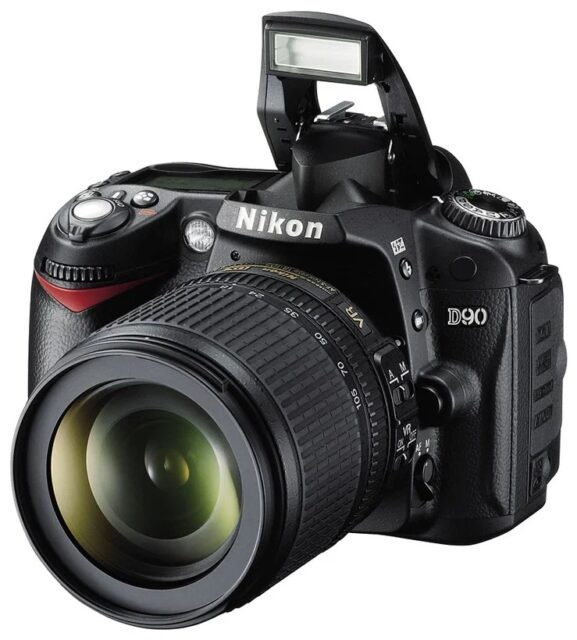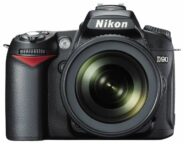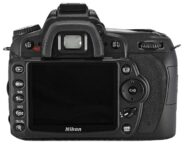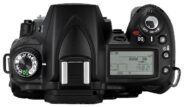Announced
Production status
System
Nikon F APS-C system cameras
- Nikon D1
- Nikon D100
- Nikon D1H
- Nikon D1X
- Nikon D200
- Nikon D2H
- Nikon D2Hs
- Nikon D2X
- Nikon D2Xs
- Nikon D300
- Nikon D3000
- Nikon D300s
- Nikon D3100
- Nikon D3200
- Nikon D3300
- Nikon D3400
- Nikon D3500
- Nikon D40
- Nikon D40X
- Nikon D50
- Nikon D500
- Nikon D5000
- Nikon D5100
- Nikon D5200
- Nikon D5300
- Nikon D5500
- Nikon D5600
- Nikon D60
- Nikon D70
- Nikon D7000
- Nikon D70s
- Nikon D7100
- Nikon D7200
- Nikon D7500
- Nikon D80
- Nikon D90
Nikon D90
APS-C AF digital SLR camera • Discontinued
Specification
| Format: | |
| APS-C | |
Imaging sensor: | 23.6 × 15.8mm CMOS sensor |
Resolution: | 4288 × 2848 - 12 MP |
Crop factor: | 1.52x |
Sensor-shift image stabilization: | - |
| Nikon F [46.5mm] | |
| Shutter: | |
Type: | Focal-plane |
Model: | Electronically controlled |
Speeds: | 30 - 1/4000 + B |
| Exposure: | |
Exposure metering: | Through-the-lens (TTL), open-aperture |
Exposure modes: | Programmed Auto |
| Aperture-priority Auto | |
| Shutter-priority Auto | |
| Manual | |
| Physical characteristics: | |
Weight: | 620g |
Dimensions: | 132x103x77mm |
Manufacturer description
Amsterdam, the Netherlands, 27 August 2008 – Nikon Europe today announces another great step forward in its mid-class DX-format D-SLR range: the D90. As the world’s first D-SLR with movie function, this remarkable camera offers truly cinematic results, stunning image quality and innovative high-performance features inherited from Nikon’s new-generation DX-format flagship D300. The D90 will open new doors for photography enthusiasts of any level.
With 12.3 megapixels, the newly-designed DX-format CMOS image sensor and Nikon’s proprietary EXPEED image processing concept, the D90 is a quality-guarantee. Advanced features such as Live View, Scene Recognition, Active D-Lighting, Picture Control and an ISO sensitivity range of 200-3200 (ISO 6400 equivalent on Hi1 and ISO 100 equivalent on Lo1), allows creativity in almost any setting. And to ensure all these features are easy to use, they are packed in an ergonomic body with an intuitive operational layout.
Toru Uematsu, Senior Manager Product Planning at Nikon Europe B.V says: “The D90’s combines imaging technology inherited directly from our D300 and innovative features like Live View, D-Movie, Scene Recognition and Picture Control - once again confirming Nikon’s leadership in cutting edge imaging technology. Add its innovative, high-performance features such as the CMOS image sensor, and the extremely wide ISO sensitivity range, we are convinced that this new camera will appeal to all passionate photographers looking for the next step in creativity.”
Stunning image quality
The D90’s EXPEED technology has been optimised to realise the high-quality, high-speed image processing capability for which Nikon’s professional D-SLRs are renowned. The D90 delivers images with extraordinary detail and expanded enlargement capacity, thanks to its improved DX-format CMOS image sensor and an effective 12.3 megapixels. The ISO sensitivity ranges from 200-3200 (ISO 6400 equivalent on Hi1 and ISO 100 equivalent on Lo1) providing low-noise images that are rich in detail and offer tonal gradation beyond expectation. It also enhances the performance of other powerful features such as Live View and the new Face Detection System. To address the issue of lost detail in high-contrast lighting situations, Active D-Lighting adjusts the contrast between images’ light and dark areas by localising tone control as an image is captured. And for extra creativity, Picture Control allows you to customise the look and mood of your images by choosing from six settings, including new Portrait and Landscape modes.
A helping hand
First introduced on Nikon’s D3 and D300 flagship cameras, the D90’s Scene Recognition System uses a 420-pixel RGB sensor to analyse scene and colour information of the subject being photographed. Based on these readings, the camera optimises its focus, exposure and white balance just before the shutter is released. The D90 also recognises human faces to render up to five faces with newfound sharpness and accuracy and more natural skin tones in your images. In the camera’s 11-point AutoFocus mode, it uses the subject’s colour information to maintain a sharp focus as the subject moves in the frame.
Once you’ve got the composition you want, the D90 incorporates image-editing functions that make it easy to enhance images within the camera. There are several new retouch options: ‘Distortion Control’ adjusts lens aberration, ‘Straighten’ corrects the inclination of the image, whilst ‘Fisheye’ produces optical effects similar to that of a fisheye lens. There are also ample options for viewing and selecting the right shot, including 72-frame playback, calendar playback and histogram display for a magnified portion of the image.
Live and living
The D90 is the first mid-class D-SLR to offer a movie function, allowing you to capture creative movie clips in motion JPEG at superb quality levels. Compared to the average camcorder, the far larger image sensor on the D90 offers higher image quality, a shallow depth of field and exceptional ISO performance while recording in low-light conditions. NIKKOR’s wide range of lenses offers great variety from fisheye to wide-angle to super-telephoto, adding more scope for creativity and emotional impact to your movies. Movies can even be played on the camera with sound, thanks to its uniquely powerful speaker / microphone system.
The D90 has been designed with an eye-level pentaprism viewfinder, offering some 96% frame coverage. However, when looking through the viewfinder isn’t practical, simply press the D90’s Live View button and the 3-inch LCD with 170? viewing angle and approx. 920k-dot LCD support your Live View shooting with three contrast-detect AF modes: Face Priority, Wide Area and Normal Area. When you’re not sure which camera settings are appropriate, try the advanced scene modes like Active D-Lighting and Picture Control for beautiful, crisp images every time.
Get every shot
There are few things more annoying than a flat battery as you’re about to capture that winning shot, so Nikon has made the D90’s extremely efficient, allowing you to capture approximately 850 images on a single charge of the camera’s battery. Accurate exposures rely on precise shutter release, so the D90’s electronically timed shutter mechanism has been specifically engineered for long, accurate service and has undergone exhaustive 100,000 shutter-release cycle testing. For ever-ready shooting, the impressive 0.15-seconds start-up time, 65-millisecond shutter release time and its 4.5 fps means you won’t lose that crucial shot. And with a thumbnail display of up to 72 images, Pictmotion slideshows with soundtrack, the option of image tagging through geotags with GPS, instant online upload to ‘my Picturetown’ and HDMI-compatibility, sharing and organising your images has never been easier.
Nikon D90 Feature Highlights
Newly designed Nikon DX-format CMOS image sensor with wide ISO sensitivity range
The D90’s 12.3 effective megapixels provides outstanding resolution, delivering images with extraordinarily defined detail. The extremely wide sensitivity range of ISO 200 to 3200 delivers incredibly low-noise throughout which can be increased to Hi 1 (ISO 6400 equivalent) and decreased to Lo 1 (ISO 100 equivalent) to expand shooting versatility. The camera also employs an Image Sensor Cleaning function that works to free image-degrading dust particles from the sensor’s optical low-pass filter.
EXPEED for smooth tones, rich colours and fine details
Nikon’s comprehensive digital image-processing EXPEED technology is optimised for the D90 to realise the high-quality, high-speed image processing capability EXPEED also contributes to the outstanding performance of other powerful features such as Live View and the new Face Detection System.
D-Movie: the world’s first D-SLR movie mode
In a world first for D-SLRs, the D90 offers a movie function, allowing you to shoot HD720p (1,280 x 720 pixels), 640 x 424 pixels or 320 x 216 pixels movies at the professional smoothness of 24 frames per second in motion JPEG format. The D90’s sensor, which is much larger than the sensor of a typical camcorder, ensures higher image quality and exceptional low-noise, high ISO sensitivity performance, even during movie shooting. Capturing creative movie clips or the drama of life’s moving moments is further enhanced by the wide selection of incredibly sharp NIKKOR interchangeable lenses that are available, from fisheye to wide-angle to super-telephoto. And Micro NIKKOR lenses bring the magic of extreme close-up imagery to movie making.
Scene Recognition System integrated with Face Detection System
The D90 precisely reads the colours and brightness information of each scene from the 420-pixel RGB sensor, and applies this to auto focus, auto exposure and auto white balance. The D90 also recognises human faces using the new Face Detection System, data which is incorporated during calculation, resulting in faces with newfound definition and accuracy as well as enabling face priority AF in Live View mode and immediate zoom into people’s faces in playback zoom.
Easy-to-use Live View mode
One press of the Live View button activates the D90’s Live View mode, delivering a bright, crisp image to the 3-in., approx. 920k-dot colour LCD and allowing comfortable shooting without looking through the viewfinder. There are three contrast-detect AF modes that let you focus on any point in the frame: Face priority AF automatically detects up to five faces and focuses on that calculated to be the closest. Wide area AF offers a large AF area suitable for handheld shooting, and normal area AF provides focus with pinpoint accuracy when using a tripod. And when Nikon VR image stabilisation lenses are in use, photographers will enjoy the benefit of a VR-smoothed image, even in Live View mode.
Picture Control System: Customize the visual style of your images
Nikon’s Picture Control System enables users to customise the look and mood of images. Six original setting options are available — Standard, Neutral, Vivid, Monochrome, Portrait and Landscape — for easy customisation of image preferences.
Active D-Lighting for smooth tone reproduction in high-contrast lighting
The D90’s Active D-Lighting accurately restores details in the shadows and highlighted areas, which are often lost in high-contrast lighting situations, by localizing tone control while shooting. There are four levels, including the new “Extra High.” Active D-Lighting can be used manually or set to Auto mode. It is also possible to bracket your pictures, allowing the capture of one image with Active D-Lighting and one without.
Versatile, practical 11-point AF system
Thanks to the Multi-CAM 1000 autofocus module, the D90’s 11-point AF system offers fast and precise autofocus coverage across the frame with the most sensitive AF sensor operating from the centre. In addition, the D90 features versatile AF-area modes to handle most shooting situations: Single-point AF is recommended for stationary subjects, dynamic-area AF for moving subjects, auto-area AF for spontaneous shooting and 3D-tracking (11 points) AF for when you want to change the composition after focusing on your subject.
Bright pentaprism viewfinder featuring frame coverage of approx. 96%
The D90 has a precise eye-level pentaprism viewfinder with approximately 96% (centered) frame coverage and an easy-to-view 19.5 mm eyepoint (at -1.0 m-1). The built-in 16-frame superimposed grid display can be activated to assist in the creation of better-balanced compositions.
Advanced Scene Modes for superior image quality
The D90 features Advanced Scene Modes: Portrait, Landscape, Close-up, Sports and Night Portrait. These modes not only adjust exposure and image processing, but also judge the optimum Active D-Lighting and Picture Control settings to obtain the best results. The D90 also recognises if VR (Vibration Reduction) is on or off and minimises noise even in dimly lit scenes.
Extensive palette of in-camera Retouch Menus
The D90’s designers incorporated a wide variety of image editing functions, making it easy for users to enhance images within the camera. The D90 introduces several new retouch options: Distortion Control adjusts lens aberration, Straighten corrects inclination of the image, while Fisheye produces optical effects similar to a fisheye lens. Engineered for precision and durability Accurate exposures rely on precise shutters and the D90’s electronically timed shutter mechanism was specifically engineered for long, accurate service. To ensure this, D90 shutters, assembled in D90 bodies, underwent exhaustive 100,000 shutter-release cycle testing.
Nikon D90 Other Features
- Gives you quick response, with 0.15-second start-up, 65 ms shutter release time lag and 4.5 fps continuous shooting.
- 3-in., approx. 920-k dot high-resolution LCD monitor with wide viewing angle that lets you change composition of the frame during shooting from various angles and easily confirm your image during playback.
- Built-in flash with 18mm lens coverage, Guide Number of approx. 18/59 (ISO 200, m/ft., 20°C/68°F) and Nikon’s original i-TTL flash control; works as a commander; controlling up to two groups of remote Speedlights.
- Highly efficient energy-saving design allows approx. 850 images on a single charge of the Rechargeable Li-ion Battery EN-EL3e. (CIPA standard, with AF-S DX NIKKOR 18-105mm f/3.5-5.6G ED VR, with 50% of pictures taken with flash)
- Extensive playback functions offer ample options for viewing and selecting the right shot, including 72-frame playback, calendar playback and histogram display for magnified portion of the image.
- Versatile Pictmotion menu creates slideshows combining five choices of both background music and image effects.
- Compatible with HDMI (High-Definition Multimedia Interface) output.
- Supports the Nikon Creative Lighting System when using the SB-900, SB-800, SB-600 Speedlight, or Wireless Close-up Speedlight System R1C1; ensures accurate exposures via i-TTL flash control.
- Multi-Power Battery Pack MB-D80 (Optional, in common with the D80) gives you the choice of using one or two Rechargeable Li-ion Batteries EN-EL3e or six R6/AA-size batteries to extend battery life.
- New optional Remote Cord MC-DC2 enables shutter release and long time exposures (bulb) remotely.
- With the new optional GPS Unit GP-1, location information such as latitude, longitude, altitude and time is automatically recorded to each image’s EXIF data.
- Included Nikon ViewNX image browsing and editing software lets you organize, label and select images as well as perform RAW image editing adjustments and conversions.
- Optional Capture NX 2 photo-editing software features patented U-Point® technology and powerful tools for quick and easy photo editing including enhanced RAW (NEF) Editing.
Similar cameras (4)
APS-C • Auto focus • Digital • Singe-lens reflex • Nikon F mount
| Model | Shutter | Metering | Modes | Year |
|---|---|---|---|---|
| Fujifilm FinePix S1 Pro | E, 1/2000 | TTL • OA | PASM | 2000 ● |
| Fujifilm FinePix S2 Pro | E, 1/4000 | TTL • OA | PASM | 2002 ● |
| Fujifilm FinePix S3 Pro | E, 1/4000 | TTL • OA | PASM | 2004 ● |
| Fujifilm FinePix S5 Pro | E, 1/8000 | TTL • OA | PASM | 2006 ● |



